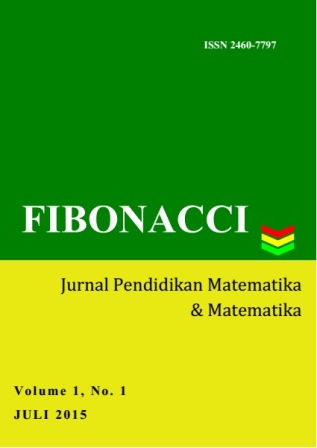PENERAPAN PENDEKATAN PEMBELAJARAN CREATIVE PROBLEM SOLVING (CPS) SEBAGAI UPAYA MENINGKATKAN KEMAMPUAN BERPIKIR KRITIS MATEMATIS SISWA
Main Article Content
Abstract
Article Details
Authors who publish with this journal agree to the following terms:
- Authors retain copyright and grant the journal right of first publication with the work simultaneously licensed under a Creative Commons Attribution License that allows others to share the work with an acknowledgement of the work's authorship and initial publication in this journal.
- Authors are able to enter into separate, additional contractual arrangements for the non-exclusive distribution of the journal's published version of the work (e.g., post it to an institutional repository or publish it in a book), with an acknowledgement of its initial publication in this journal.
- Authors are permitted and encouraged to post their work online (e.g., in institutional repositories or on their website) prior to and during the submission process, as it can lead to productive exchanges, as well as earlier and greater citation of published work (See The Effect of Open Access).
References
Depdiknas (2006). Kurikulum Tingkat Satuan Pendidikan; Standar Kompetensi
Matematika SMP/MTs. Jakarta: Depdiknas.
Ennis, R. H. (1996). Critical Thinking. United States of America: Prentice-Hall Inc.
Facione, Holistic Critical Thinking Scoring Rubric. [Online] Tersedia:
http://www.calstatela.edu/academic/aa/assessment/assessment_tools_resources/r
ubrics/scoringrubric.pdf [5 Desember 2012].
Fisher, A. (1995). Critical Thinking An Introduction. New York: Cambridge University
Press.
Glazer, E. (2001). Using Web Sources to Promote Critical Thinking in High School.
[Online] Tersedia: http://math.unipa.it/Aglazer [17 September 2012].
Hake, R. (1999) Analizing Change/Gain Scores. [Online] Tersedia:
http://www.physics.indiana.edu/-sdi/AnalyzingChange-Gain.pdf [15 Desember
.
HOSA (2011). Creative problem solving. Event Guidelines. [Online] Tersedia :
http://www.hosa.org/natorg/sectb/cat-iv/cps.pdf. [6 Mei 2013].
Isaksen, S. G. (1995). “ On the conceptual foundation of creative problem solving: a
response to Magyari-Beck”. Journal of Cretivity and Innovation Management.
Vol. 4 (1), hal: 52-63.
Isaksen, S. G. (1996). Transforming Dreams Into Reality: The Power of Creative
Problem Solving. [Online] Tersedia:
http://www.cpsb.com/research/articles/creative-problem-solving/Dreams-Power
of-Creative-Problem-Solving.pdf. [7 Agustus 2012 ].
Isaksen, S. G. (2005). Creative Problem Solving: The History, Development, and
Implications for Gifted Education and Talent Development. New York:
Cambridge University.
Johnson, E. B. (2007). Contextual Teaching & Learning. Bandung: Mizan Learning
Center.
Mitchel, W. E, dan Thomas F. (1999). Kowalik. Creative Problem Solving.
GenigraphicsInc. Cet.III.
NCTM (1989). Curriculum and Evaluation Standard for School Mathematics. Virginia:
The NCTM Inc. [Online]. Tersedia: http://www.nctm.org/focalpoints. [08
Oktober 2012].
NCTM (2000). Principles and Standards for School Mathematics. Reston: Virginia.
NCTM (1991). Evaluation of Teaching: Standard 6: Promoting Mathematical
Disposition. [Online]. Tersedia:
http://www.fayar.net/east/teacher.web/math/Standards/previous/ProfStds/EvTea
chM6.htm. [5 November 2012].
Noortsani, I. (2013). “Peningkatan Kemampuan Pemahaman dan Pemecahan Masalah
Matematis Siswa SMA di Kabupaten Cianjur Melalui Pendekatan Creative
Problem Solving”. Tesis, Pascasarjana UPI.
Pepkin, K. L. (2000). Creative Problem Solving in Math. [Online] Tersedia: http://m2s
conf.uh.edu/honors/honors-and-the-schools/houston-teachers-institute/curriculum-units/pdfs/2000/articulating-the-creative-experience/pepkin-
-creativity.pdf ,[28 Nopember 2012].
Ruseffendi, E. T. (1991). Penilaian Pendidikan dan Hasil Belajar Siswa Khususnya
dalam Pembelajaran Matematika untuk Guru dan Calon Guru. Bandung:
Diktat.
Ruseffendi, E. T. (2005). Dasar-dasar Penelitian Pendidikan dan Bidang Non-Eksakta
Lainnya. Bandung: Tarsito.
Soedjadi, R. (1995). Pendidikan, Penalaran, Konstruktivisme, Kreativitas sajian dalam
Pembelajaran Matematika. Makalah tidak diterbitkan.
Somakim. (2010). Peningkatan Kemampuan Berpikir Kritis dan Self-Efficacy
Matematik Siswa Sekolah Menengah Pertama dengan Penggunaan Pendekatan
Matematika Realistik. Disertasi pada Sekolah Pascasarjana UPI. Tidak
diterbitkan.
Sumarmo, U. (2006). Berpikir Matematik Tingkat Tinggi. Makalah pada Seminar
Pendidikan Matematika UNPAD, Bandung.
Sumarmo, U. (2010). Berpikir dan Disposisi Matematik: Apa, Mengapa, dan
Bagaimana Dikembangkan Pada Peserta Didik. Bandung: FPMIPA UPI.
Suryosubroto, B. (2009). Proses Belajar Mengajar di Sekolah. Jakarta: PT Rineka
Cipta.
Treffinger, D.J., S.G. Isaksen, K.B. Dorval. (2003). Creative Problem Solving (CPS
Version 6.1
Tersedia: http://www.creativelearning.com/PDF/CPSVersion61.pdf [9 Juli
.

